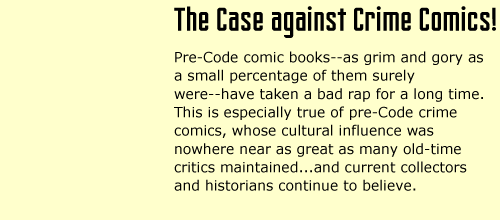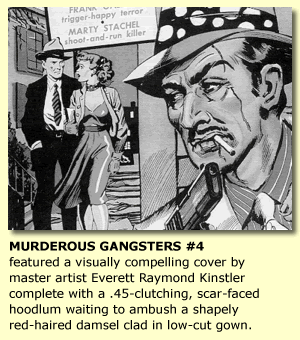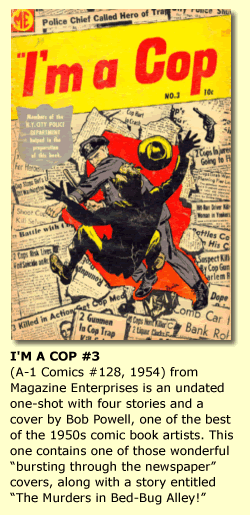
by Michelle Nolan
When I was asked to do a piece on crime comics, I accepted the challenge because I thought it would offer an ideal opportunity to expose many misconceptions, some of which have plagued the comic book industry for five decades.
Even though I feel the case against the genre is generally a frame-up, this will be no defense of the few truly offensive crime comics. As CBM readers know, these grisly examples of four color controversy have emerged from the mists of time as some of the most interesting, rare, and collectible examples of “bad taste” in the history of American pop culture.
This installment of Nolan’s Notebook is not intended to be a rehash of crime comics history...nor an edictment of the censorship efforts that eventually stopped their publication. That ground has been examined for clues many times, especially in Mike Benton’s nicely done 1993 book Crime Comics. Instead, I’d like to take a look at this highly collectible genre from a new perspective...examining the statistical evidence in the case against crime comics...and perhaps asking the question “Were crime comics really as bad as everyone believes?”
 There’s
no question that several hundred different issues of crime comics published
in the 1942-54 period represent a form of media that is distinctly distasteful,
especially with regard to youngsters.
There’s
no question that several hundred different issues of crime comics published
in the 1942-54 period represent a form of media that is distinctly distasteful,
especially with regard to youngsters.
But consider what has occurred in American culture during the nearly half a century since the attacks on crime and horror comics reached a crescendo in the 1948-54 period, resulting in the creation of the Comics Code Authority.
Does anyone seriously think the problems of juvenile delinquency are less serious in the United States now than they were nearly half a century ago? Hindsight is wonderful, of course, but it’s obvious now that comic books hardly could have had the influence that many critics contended they had.
With a few exceptions, comic books have steadily declined as a mass-market medium over the past 50 years. The concept that comic books seriously affect juvenile crimes today would be seen as ludicrous by trackers of pop-culture trends.
It will always be a matter of debate to what degree the media of all types affect deviant social behavior. However, I’m certain that over the past five decades, television, films and music have ever increasingly had a much more serious affect on behavior and social trends of all types than comic books.
There’s no question about that today, of course, since almost all children are exposed to far more television and films than comic books.
 However,
many have suggested that the content of what youngsters see on television
or in the movies today is potentially far more harmful than what was published
in pre-Code crime comics. I’m not saying that is definitely the case,
but merely that popular culture exposes youngsters to some pretty crude
(and violent) images today.
However,
many have suggested that the content of what youngsters see on television
or in the movies today is potentially far more harmful than what was published
in pre-Code crime comics. I’m not saying that is definitely the case,
but merely that popular culture exposes youngsters to some pretty crude
(and violent) images today.
There is no question in my mind that long ago comic book critics such as Dr. Fredric Wertham confused cause and effect, or, to put it another way, the chicken and the egg.
It only stands to reason that the majority of troubled and troubling youngsters read comic books, since most youngsters from most backgrounds did in those years before television became such a pervasive influence and distractions such as video games and rock music did not exist.
Such youngsters, most of whom came from lower socio-economic backgrounds, were surely exposed to good literature to a much lesser degeree than upper class youth. Even though a handful of youngsters were incluenced by the crime comics, how much influence do you really think they had with the majority of youngsters from all backgrounds?
What all that leads up to is my cotention that the influence of crime comics was greatly overestimated in the 1948-54 period, primarily because they were a new aspect of popular culture and an easy target for politiicans of all sorts, ranging from United States senators to school PTA leaders.
 How
could any critic, no matter how sincere or no matter what his or her agenda,
lose with an attack on crime comics? There could have been no easier target.
How
could any critic, no matter how sincere or no matter what his or her agenda,
lose with an attack on crime comics? There could have been no easier target.
There’s no question that many crime comics deserved criticism, however fondly we may view them today for their funky collectibility. Who could possibly defend the reading by children of lurid comics such as Fox’s Crimes By Women?
Nevertheless, I seriously doubt if Crimes By Women led many virtuous girls--or boys--to take up a life of crime or to participate in activities they would not otherwise engage in, any more than slasher films produced a generation of slashers. The entire tempest of comic book criticism was as tasteless in its own way as the comics the critics attacked.
Most type of comic books dealt with some sort of conflicts, so in the eyes of Wertham and others, most comic books could be classified as “crime comics.” It’s hard to argue with his logic; crimes committed in outer space, the battlefield, the old West against superheroes and even in Duckburg were still crimes. (You bet those Beagle Boys were crooks!)
Even so, genuine crime comics constituted a distinct minority of all comics published, even during the 1948-54 period.
Dan Stevenson, an outstanding indexer who has done more research than anyone else with regard to comic book titles and numbers, lists some 17,873 comics published during 1948-54, give or take a few that still aren’t certain to exist. Of those, Stevenson lists only about 1,500 (once again give or take a few cross-genre oddballs) that could be considered pure crime comics.
That’s fewer then 10 percent of all comics on the newstands.
|
Where have all the readers gone? In 1948, many surveys showed that well over half the youngsters in the United States were regular readers of comic books. I’ve seen surveys that found at least four out of every five youngsters in the country were familiar with comic books, albeit often on a pass-around basis, during the 1940s and ’50s. Virtually everything produced by the large corporate comic book publishers sold at least 200,000 copies in a nation only about half as populous as today. Sales of fewer than 100,000 to 200,000 copies of anything produced, for example, by DC or Dell would have been grounds for cancellation during the Golden and Silver Age. Today, only a handful of comic books sell more than 100,000 copies, and the vast majority of these go to collectors or are sold in comic shops to regular readers. I would bet that if you took a poll of any 1,000 United States youngsters aged 8-12, fewer than 50 would declare themselves regular readers of comics books--even as few as two or three comics per week. In my work as a free-lance writer, I often interview teachers. Many of them have told me that they have entire classes in which only two or three youngsters read comic books. For that matter, several elementary and high-school teachers have told me that anywhere from 50 to 90 percent of their classes do little, if any, recreational reading...at all! (That is hardly surprising in a country where only 10 percent of the population is responsible for more than 90 percent of the book sales.) How many CBM readers know any kids that read (even comic books) on a regular basis...as opposed to watching television, playing video games, or logging onto the Internet? That question is important in any attempt to understand the state of reading in this country and access the influence--or lack of it--of comic books on our culture. But don’t despair, fellow CBMers. Educational institutions are continuing to re-emphasize the importance of reading, literacy campaigns blanket the country, and the quality and attractiveness of children’s books has reached an amazing level. As we face the turn of the century, I think the forecast for the future of young readers is looking pretty bright! |
Likewise, Ernie Gerber, in Volume 2 of his monumental Photo-Journal, graphed the market share of comics genres through 1970. It’s impossible to know exactly where each title fit in his research, but the figures seem on the money.
Crime comics went from a three percent market share in 1946 to nine percent in 1947, then reached 14, 12, 10 and 13 over the 1948-51 period before declining to 6, 6, 7 and 6 through 1955. Once again, the market share over the 1948-54 period is less than 10 percent.
Contrast this with Gerber’s assessment of romance comics (not including teen comics), which began with one percent market shares in 1947 and 1948 before leaping to 23 and 27 percent, respectively, in 1949 and 1950. In the years 1951 through 1956, as crime comics seriously declined and then nearly vanished, romance comics maintained a market share of 14 or 15 percent every year.
It’s my contention that the only reason crime comics achieved any real popularity at all was that they basically replaced super and costumed hero comics for a few years.
In one classic case, the long-running costumed hero Spy Smasher from Fawcett was renamed Crime Smasher. Crime Smasher, however, ran only one issue (1948) in his own title and in only eight issues of Whiz Comics (#76-83), ending in March 1947. Spy Smasher, on the other hand, was so popular that the character not only ran in 75 issues of Whiz, but was made into a smashing movie serial in 1942, starring Kane Richmond.
Crime comics were published primarily in anthology formats. Even if the Comics Code had not spelled doom for them, their days were numbered anyway because the anthology format became increasingly unpopular in the 1950s and ’60s.

